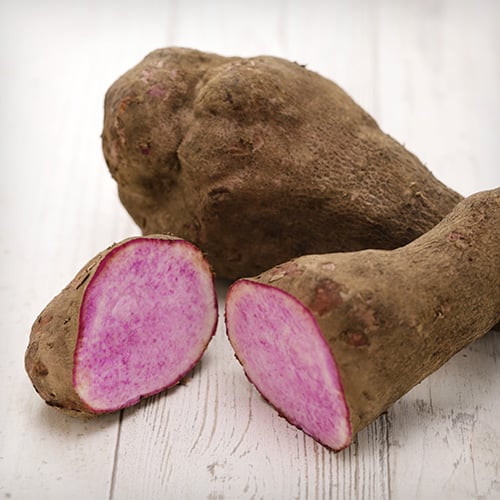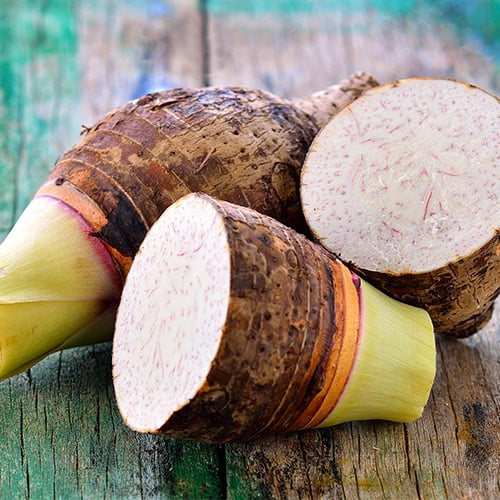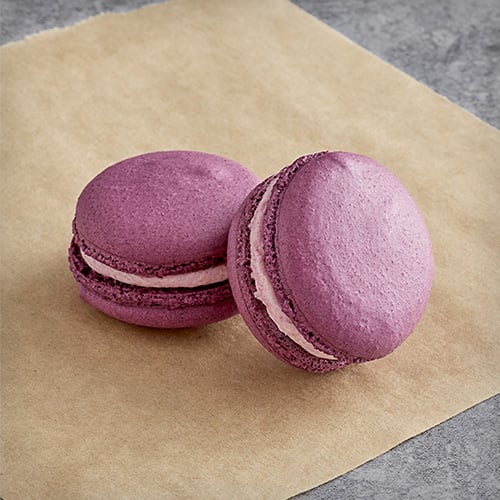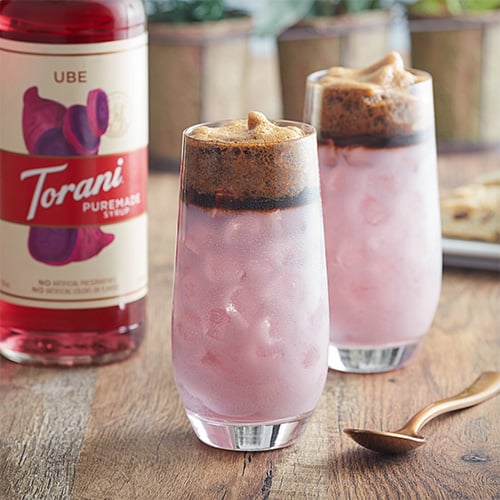Known for its vibrant-purple hues, ube is a Southeast Asian yam that quickly captured the attention of foodies all over social media. Often used as a natural food coloring, ube has a sweet but nutty flavor that makes it an excellent ingredient for your dessert menu. So, what is ube made of and how does one use it? We explore this unique tuber below.
What Is Ube?

Ube (Dioscorea alata) is a purple yam that is native to Southeast Asia and predominantly used in Filipino cuisine. This starchy tuber has a distinct purple-colored flesh that varies in shade and features a nutty, vanilla flavor. It is often used in desserts, from cakes to ice creams, to provide sweetness and color.
How to Pronounce Ube
The correct ube pronunciation is “oo-bay”. The word means “yam” or “tuber” in Tagalog, a native language in the Philippines. It is occasionally referred to as ubi or winged yam when sold in seed catalogs in the United States.
What Does Ube Taste Like?
The distinct ube flavor is slightly nutty with a hint of vanilla. It has a coconut-like aroma that lends itself well to dessert items. Ube is most often boiled, mashed, and mixed with condensed milk to bring out its sweetness.
What Does Ube Look Like?
Ube yams have a rough, dark-brown skin that is usually bark-like in texture. The inside flesh ranges in color, from pale pink to deep lavender, almost fuchsia. It is often mistaken for taro root or purple sweet potatoes, but they are, in fact, different root vegetables.
Ube vs Taro

Ube and taro are both tubers with bark-like skin and pink-hued flesh. The difference between taro and ube is that taro has a subtle, earthy, potato-like flavor while ube is nutty with a vanilla-like flavor. Taro flesh is usually white with a few pink freckles, whereas ube is mostly pinkish-purple with the occasional white freckling depending on the root. Taro root is also much larger than ube. It is used for savory and sweet dishes instead of mainly just desserts like ube.
Ube vs Purple Sweet Potato
Ube is often mistaken for a purple sweet potato because of its violet flesh, but the two are not the same. The difference between ube and purple sweet potato is that ube is a yam instead of a sweet potato. This means that the skin of the ube is rough and bark-like instead of thin and smooth like that of the purple sweet potato.
The flesh of purple sweet potatoes is consistently a deep purple-to-fuchsia color, whereas ube flesh can vary from light violet to dark lavender. Ube flesh contains more moisture than sweet potato, making it a better ingredient to bake with. Although both tubers are sweet and receive their color from anthocyanins, ube is nuttier in flavor and contains a higher level of vitamin A, vitamin C, and potassium than purple sweet potatoes.
How to Cook Ube
Ube is not typically found in its raw form in the United States, more often available in powdered and extract forms. Raw ube contains some toxins and should be cooked down before serving. To cook ube, follow these steps:
- Wash the ube skins thoroughly.
- Boil the whole root for 30-40 minutes.
- Peel off the skins and cut.
- The soft flesh can now be used for your ube recipes.
Popular Ube Foods
If you’re ready to start incorporating ube into your menu, try some of these most common ube foods for a whimsical splash of color:

- Ube Halaya - One of the most popular ube recipes in the Philippines, ube halaya (also known as ube jam) is a pudding made with boiled purple yam. Coconut milk, sugar, and butter are added to the mashed ube and simmered. The final result is either eaten as is, spread on bread, or used in other ube desserts.
- Halo-halo - Also known as haluhalo (the Tagalog word for “mixed”), halo-halo is a type of frozen dessert made with shaved ice and ube halaya. It is then paired with an assortment of toppings, like sweetened beans, jellies, and fruits. Most chefs serve halo-halo with ice cream, pie, or flan for the perfect sweet treat.
- Ube Ice Cream - Made by churning ube extract or ube powder with cream, ube ice cream is a sweet and nutty dessert that is often paired with halo-halo.
- Ube Extract - Ube can be steeped in alcohol to create a purple yam extract. This extract is often used to make ube syrups that provide color and flavor to cocktails, juices, and sodas.
- Ube Powder - Powdered ube is made from boiled ube that is mashed, dehydrated, and ground into a powder consistency. Purple yam powder can then be mixed with water or added to recipes for that vibrant purple coloring and nutty, vanilla flavor. Ube powder is excellent for smoothies, hot chocolate, bread, cakes, and elegant desserts like these ube macarons.

Ube FAQs
Below, we answer some of the most common questions about purple yams.
Where to Buy Ube
Ube can typically be purchased in Asian grocery stores or international aisles of larger supermarkets. While finding raw ube is rare in the United States, ube powder, ube extract, and frozen ube are more readily available.
Is Ube Taro?
Ube is not the same as taro. Although both are root vegetables with bark-like skin, ube is sweeter and has pinkish-purple flesh while taro is earthy and has white flesh with pink flecks.
Where Is Ube From?
Ube or purple yams mainly grow in the Philippines but can be found throughout Southeast Asia.
Ube Health Benefits
Ube is a good source of healthy carbs, vitamins, antioxidants, and fiber. A 3.5-ounce serving will typically have 27 grams of carbohydrates, 4 grams of fiber, 13% daily value of vitamin C, and 11% daily value of vitamin A. Despite its health benefits, ube is usually served in dessert recipes which should be enjoyed in moderation. Keep in mind that ube root contains some toxins in it and should never be consumed raw.
If you’re looking to spruce up your menu and get customers talking, ube might just be the burst of color you need. You can make your business an Instagram-worthy hotspot by adding ube desserts for your customers to pair with vibrant bubble tea selections.
Related Resources

Tropical Fruits List
If you own a restaurant, you’re probably curious about different ingredients from around the world, and how you can utilize all of them in new, exciting recipes. If you own a juice or smoothie bar, chances are you need to learn how to use a variety of fruits for your menu. Below is a list of tropical fruits so you can bring a bit of the sunny tropics to your menu easily and deliciously. Before starting, make sure all of your fruits are properly washed to keep your customers safe. Use these links to learn more about specific tropical fruits: Dragon Fruit Passion Fruit Rambutan Acai Jackfruit Mangosteen Lychee Papaya Guava <iframe itemprop="embedURL" width="560" height="315" src="https://www.youtube.com/embed/opo6QGMtZuc?si=aRFhw9wZ9o71tZvC" frameborder="0" allowfullscreen></iframe> List of Tropical Fruits Many common tropical fruits are native to the countries that lie along the Earth’s equator. Below is a tropical fruits list so you can become familiar with some of the different types of tropical fruit: 1. Dragon Fruit (Pitaya) Dragon fruit, otherwise known as Pitaya, has a vibrant pink, thick outer skin with spikey-looking green growths. Dragon fruit is usually pink on the outside with a white or vibrant pink flesh and dotted with small black edible seeds throughout. Dragon fruit can sometimes have yellow skin as well, and this variety only has a white flesh with small black edible seeds. What does dragon fruit taste like? Very mild with sweet undertones, reminiscent of a kiwi and pear Dragon Fruit Origin: South and Central America as well as Southern Mexico How to Prepare Dragon Fruit Cut the dragon fruit down the center lengthwise, exposing the seedy flesh. From here, you can cut it in half again for more exposure to the flesh if you’d like. Now you have a couple of options: you can peel away the skin so you are left with the flesh intact, or you can scoop the flesh away from the skin with a spoon, melon baller, or disher/ice cream scoop. However you do it, be sure to throw away the dragon fruit’s skin because it is inedible. How to Eat Dragon Fruit Because dragon fruit has such a mild flavor and beautiful flesh, it’s best to showcase those features. Cut up dragon fruit and toss it into a fruit salad to liven it up, or use it as a topping for smoothie bowls or yogurt parfaits. You can also use dragon fruit in a smoothie or as the base of a smoothie bowl, especially if you have the hot pink-fleshed pitaya. What Goes with Dragon Fruit? Fruits that go well with dragon fruit are pineapple, mango, bananas, oranges, papaya, strawberries, and lemon. Shop All Frozen Dragon Fruit Back to Top 2. Passion Fruit (Liliko'i) Passion fruit, otherwise known as Liliko'i in Hawaiian, is a type of tropical fruit that has a hard purple or yellow outer shell with a jelly-like golden pulp and seed-filled center. The purple passion fruit will have black seeds and the yellow liliko'i will have brown seeds. Passion fruit seeds are crunchy and edible, but tart-tasting. What does passion fruit taste like? Acidic, tart, and surprisingly sweet compared to the other tasting notes Passion Fruit Origin: Subtropical regions of South America, such as Brazil, Bolivia, Argentina, Uruguay, and Paraguay How to Prepare Passion Fruit When your passion fruit’s outer skin is wrinkly, it’s perfectly ripe and ready to prepare. To start the preparation of the passion fruit, cut it in half with a serrated knife to make a clean cut. Next, take a spoon and scoop out the pulp. Whether you’re scooping out the passion fruit pulp into a clean bowl, fine-mesh sieve, or on top of a cake or pie is up to you and your recipe! How to Eat Passion Fruit The pulp of the passion fruit and the seeds of the passion fruit can be eaten as is and are great scooped onto a cake, pie, pavlova, or smoothie bowl to create a beautiful finishing touch thanks to the vibrant colors. Try using passion fruit to make a lilikoi butter, AKA passion fruit curd, and use it in malasadas and other donuts, passion fruit bars, as a filling for cakes or pate a choux, or in pavlovas. It also adds a healthy burst of flavor to smoothies or raw vegan desserts. Passion fruit also makes an excellent syrup to flavor cocktails. What Goes with Passion Fruit? Fruits that go well with passion fruit are papaya, melons, banana, mangoes, and vanilla. Passion fruit also pairs extremely well with milk-based foods like yogurt, cream, and custard. Passion fruit pairs well with other bitter and tart fruits when there is a large amount of milk-based products in the recipe, like a lemon and passion fruit cheesecake. Shop All Frozen Passion Fruit Back to Top 3. Rambutan Rambutan is a tropical fruit with a red shell and soft, hair-like spikes surrounding the outside of the red shell. Rambutans are plum-sized, and under their red skin is a soft, translucent, grape-like fruit with an inedible brown seed in the middle of the fruit. What does rambutan taste like? Sweet, slightly astringent, with strawberry notes Rambutan Origin: Southeast Asia, Australia, and Hawaii How to Prepare Rambutan To prepare a rambutan, take a sharp knife and carefully peel away the red skin. There may come a point where you can peel the skin away by hand. You should be left with the translucent flesh. Break open the flesh and take out the inedible seed. Now you are left with just the sweet fruit! How to Use Rambutan Rambutan is great raw and by itself, but there are plenty of ways to use them in other recipes. Add rambutan into a fruit salad, or try sticking a toothpick or cocktail pick through them and placing the rambutan in a drink as a garnish. Try rambutans in a sorbet, or plop them into a blender with frozen fruits and make a smoothie or smoothie bowl. What Goes with Rambutan? Fruits that go well with rambutan are other fruits that have a lot of flavors, such as mango, lemon, lime, coconut, pineapple, and passion fruit. Try basil or mint when pairing rambutan with herbs. Back to Top 4. Acai Acai (pronounced “ah-sigh-ee”) are small, dark purple berries that are loaded with tons of health benefits. In the United States, acai is found pre-pureed, frozen, scooped into plastic packets, then sold at grocery stores. It can only be served frozen because the juice from acai berries must be eaten within 24 hours of extraction. In the Amazon, acai berries are soaked to soften the skin, then mashed to form a paste. The acai paste oftentimes accompanies savory meals with fish or cassava, or is made into ice cream or acai bowls. What does acai taste like? Earthy and creamy, with unsweetened chocolate and blackberry notes Acai Origin: Amazon rainforest, Central and South America How to Use Acai Acai is most notably known for making acai bowls. Acai can also be used for smoothies, raw vegan desserts, ice cream, sorbet, or popsicles. What Goes with Acai? Fruits that go well with acai are bananas, blueberries, strawberries, coconut, passion fruit, pineapple, oranges, cacao, dragon fruit, and cherries. Other great pairings are nut butter, granola, chocolate spreads, and sweeteners like guarana, honey, agave, or maple syrup. Shop All Frozen Acai Back to Top 5. Jackfruit Jackfruit is a tropical fruit with an impressive size of anywhere between 8 inches to 3 feet tall, with its weight varying even greater at 10 to 110 pounds! The outside of the jackfruit has a green spiky skin that’s thick and unyielding. Inside, there is a white, fibrous surface that holds the golden yellow jackfruit pods. The jackfruit pods are the edible part of the jackfruit, and each pod has a seed on the inside that is edible after boiling. What does jackfruit taste like? Unripened jackfruit tastes mild with a small hint of sweetness, and ripe jackfruit tastes very syrupy-sweet with tangy undertones Jackfruit Origin: South and Southeast Asia, Africa, and South America How to Prepare Jackfruit To cut jackfruit, take a sharp knife and carefully lather oil on the blade. Pierce the knife through the jackfruit’s skin and cut the jackfruit in half length-wise. Once it’s opened, cut out the white sappy core. You should now have the golden-yellow jackfruits pods exposed. By hand, take out the jackfruit from its pods, and place it into a bowl to use the fruit when ready. Remove the seed inside of the jackfruit, but make sure to save the seeds to boil and eat as they’re packed with extra nutrients! How to Use Jackfruit Jackfruit has tons of different uses, and the use depends on how ripe the jackfruit is. If the jackfruit is unripe, then it is best for vegan and vegetarian food as a meat substitute due to its texture and mild, unripe flavor. Use unripe jackfruit for vegan BBQ pulled jackfruit sandwiches, stir-fries, curries, teriyaki bowls, Jamaican jerk jackfruit wraps, vegan pot pie, jackfruit crab cakes, and barbacoa jackfruit tacos. If you’re using ripe jackfruit, it’s really great eaten as is, but jackfruit can also be tossed into a fruit salad or smoothie for an unexpected fruit. Jackfruit also is traditionally made into kathaler mishti pakora, which is sweet jackfruit fritters, or made into chakka varatti, which is jackfruit jam. Jackfruit has even been used in quick bread such as muffins and bread loaves when paired with other tropical fruits like coconut and bananas. You can even try making a brown sugar jackfruit upside-down cake! What Goes with Jackfruit? Fruits that go well with jackfruit are mangoes, pineapples, bananas, and coconut. Darker sweeteners also pair well with jackfruit, like molasses, brown sugar, date syrup, and jaggery. Back to Top 6. Mangosteen Mangosteen is a type of tropical fruit that has a purple outer shell with beautiful translucent-white fruit on the inside. The fruit is naturally sectioned off into segments, and you can tell how many segments will be in the mangosteen by looking at the bottom of the mangosteen at the flat, flower-shaped growth and counting the “petals” that the flower shape has. When opened, the smaller segments tend to have no seeds, while the bigger segments usually have an inedible seed. What does mangosteen taste like? Pineapple, strawberry, and lychee Mangosteen Origin: Southeast Asia, more notably the Sunda Islands How to Open Mangosteen Press firmly with your thumb into the purple skin of the mangosteen until you break the skin, then peel away the rest of the skin. You should now be left with the mangosteen fruit segments as well as the seeds inside. If the skin is too hard to crack open with your hands, use a serrated knife to carefully cut a 1/4” deep incision around the circumference of the mangosteen and lift away the top. From there you can pull apart the rest of the skin of the mangosteen. How to Use Mangosteen Mangosteens are best eaten raw as is right from their shell, but they’re also nice when tossed in a fruit salad with lime or mint syrup. They’re also great in a smoothie, made into ice cream, or used in traditional Asian desserts, just be sure to take out the seeds first! What Goes with Mangosteen? Fruits that go well with mangosteen are strawberries, bananas, papayas, passionfruit, and pineapple. Different Types of Mangosteens There are a couple of different types of mangosteens as well that are also worth noting: Lemon mangosteen (Gamboge) Lemon mangosteen, also known as gamboge, has a bright yellow outer shell with matching fruit. The fruit has the texture of a mango, the flavor of a lemon, and is high in vitamin C. The inside of the fruit has a large, inedible seed, and the skin of the lemon mangosteen is edible. African Mangosteen (Imbe) African mangosteen, otherwise known as imbe, is a kumquat-sized fruit that has a thin and vibrant orange outer skin that peels by hand very easily. It can have one or two very large seeds in the middle and does not yield a lot of fruit. Therefore, it is usually used for ornamental decor. African mangosteens taste sour, tart, and slightly sweet with mango-like undertones. Back to Top 7. Lychee Lychee is a tropical fruit with a thin, hard, and easily breakable pink skin with translucent-white flesh underneath. The fruit has a large, inedible seed in the middle. Lychee fruit is usually the size of a grape. What does lychee taste like? A cross between a watermelon and a strawberry Lychee Origin: Southeast Asia How to Prepare Lychee To peel the skin off lychee, break open the hard skin with your nail, and start to peel away the rest of the skin and discard. You should be left with the white-translucent fruit with the inedible seed on the inside. To remove the seed, score the white fruit down the center and pluck out the seed. There may be leftover seed membrane stuck on the inside, which is edible and very difficult to remove. How to Use Lychee Lychee is great eaten raw, so enjoy as is or toss it in a fruit salad. You can also put lychee into a smoothie, use it to make ice cream, or make various Asian desserts that traditionally use lychee. Lychee syrup is great for cocktails, especially if you have access to lychee fruit and can use it as a garnish. Because of lychee’s mild sweetness, it’s a perfect ingredient to add dynamism to savory dishes, such as sweet and sour sauces for stir-fries, or even barbecue sauces if you want to take your grilled meats up a notch. What Goes with Lychee? Fruits that go well with lychee are pineapple, citruses, mango, coconut, banana, and passion fruit, and most tropical fruits. When pairing lychee in cocktails, try using tequila, vodka, and sake, with a small splash of vanilla to bring it all together. Shop All Frozen Lychee Puree Back to Top 8. Papaya Papaya is a large, teardrop-shaped fruit with a green or yellow, thin, and yielding outer skin. The inside is a luscious, soft, and salmon-colored fruit with a cluster of black, shiny, and small seeds that are edible, but should only be consumed in moderation. What does papaya taste like? Mild and slightly sweet with a creamy and spoonable texture Papaya Origin Central America How to Prepare Papaya Cut the papaya in half length-wise to expose the black seeds. Scoop out the black seeds and discard. Now, run a knife right on the edge of where the pink fruit meets the green skin to separate the two. Or, you can scoop out the fruit away from the skin. You should now be left with just the fruit of the papaya. Another option to cut the papaya is cutting off an inch from the bottom to let the papaya stand on a flatter surface. Stand your papaya on its new flat surface, take your knife, and carefully peel off the skin of the papaya. Now, cut the papaya in half length-wise and scoop out the seeds. You should now be left with just the pink flesh of the papaya. How to Use Papaya Papaya halves still in their skin with the seeds scooped can be eaten as-is with a squeeze of lime or with passionfruit spooned on top of it. Papaya also makes a perfect base for a smoothie thanks to its texture and mild flavor. You can also use papaya for yogurt bowl toppings, chopped into salsa, or broken down into a jam. Papayas can also be used in salads as a pop of freshness. What Goes with Papaya? Fruits that go well with papaya are passion fruit, lychee, mango, guava, pineapple, and strawberries. The tangier the fruit, the better, as papayas mild taste could use a complementing but outstanding flavor pairing. Otherwise, it can also pair well with more mellow fruits, such as dragon fruits, melon, bananas, and mangosteen. Shop All Frozen Papaya Back to Top 9. Guava Guava is a type of tropical fruit with a think green-yellow outer skin and pink or white center. Guava is around the size of an apple, and when ripe it should be very juicy and soft. The skin and seeds of guava are edible as well! What does guava taste like? Fruity and floral with notes of strawberry Guava Origin: Mexico, Central America, South America’s northern region, as well as the Caribbean How to Prepare Guava Cut the guava in half length-wise to expose the flesh. From here you can cut per your recipe, or scoop out the flesh and use immediately or refrigerate/freeze the guava until ready for use. How to Use Guava Guava is traditionally served simply with either salt, chili powder, or plum powder sprinkled on. Guava also makes a fantastic smoothie or smoothie bowl base. Jam is also another great use for guava, or a guava syrup that can be used in cocktails. Guava has been used in barbecue sauces for an extra pop of a sweet flavor on meat and fish! What Goes with Guava? Fruits that go well with guava are cherries, apricots, plums, strawberries, coconut, mangoes, bananas, pineapple, pear, and citrus fruits. Shop All Frozen Guava Puree Tropical Fruits List Chart Check out our tropical fruits infographic below for a fun visual guide! Back to Top Tropical fruits are filled with flavor, color, and added nutrients, and using them to create traditional or innovative menu options is a great way to stand out from the competition if these are not the usual fruits that grow in your region.

What Is Grass Jelly?
Grass jelly, also known as leaf jelly or herb jelly, is a traditional Asian herbal dessert. It is commonly consumed in East and Southeast Asian countries such as China, Taiwan, and Thailand. Grass jelly can be served chilled or at room temperature and is most often used as a jelly-like topping in drinks and desserts, like bubble tea. Shop All Grass Jelly Products What Does Grass Jelly Taste Like? Though its taste isn't particularly distinct or overpowering, grass jelly typically displays an herbal taste with a hint of mint. Its mild taste pairs well with honey, syrup, and other sweet ingredients. If you’re making your own grass jelly, the intensity of its flavor is dependant on how you prepare it. What Is Grass Jelly Made Of? The main ingredient in grass jelly is a plant called Chinese mesona. The plant is commonly found in East Asian countries such as China and Taiwan, and typically grows in grassy, dry, and sandy areas. It's important to note that both the leaves and the stems of mesona are used as ingredients as you cook. Corn starch and potassium carbonate are also key ingredients in the cooking process. How to Make Grass Jelly Making grass jelly is relatively easy to do as long as you have the right ingredients. If you plan on making it the traditional way, it's essential to make sure you have Chinese mesona and corn starch. To make your own grass jelly, follow the steps below: Begin by drying Chinese mesona in the sun, allowing it to oxidize. Place the dried stems and leaves in a pot and boil them for a period of up to eight hours. Add corn starch to the pot to thicken the mixture. Once your grass jelly has thickened into a gelatinous form, place it in the refrigerator to chill and let the mixture set. Making grass jelly can be rewarding, but it can also be time-consuming. To save yourself time or streamline the process, consider using products like canned grass jelly or grass jelly powder. What Is Grass Jelly Powder? Among the many forms this unique dessert comes in, grass jelly powder is perhaps the easiest to prepare. Rather than preparing the dessert from scratch, grass jelly powder can simply be added to a pot of boiling water and cooled, saving you valuable time in the kitchen. Additionally, it’s important to note that the powder can be used for more than just preparing grass jelly. It can also be added as an ingredient in icing, whipped cream, and other similar products to create a grass jelly flavored topping. How to Use Grass Jelly Thanks to its versatile texture and it's multiple forms, grass jelly can be a unique and delicious addition to many recipes. Below, we'll investigate some of the most common ways to use grass jelly: Grass Jelly Drink Similar to the boba balls found in bubble tea, grass jelly can be served in a mixture of milk, tea, or juice. Grass jelly drinks usually feature cubes or slivers of grass jelly to provide a striking contrast against light-colored milk teas. Not only are these drinks easy to prepare, but grass jelly is lower in calories than boba tea, making jelly boba a healthier type of boba. Grass Jelly Dessert Bowl Many Asian cultures feature their own version of a grass jelly dessert bowl, giving you a variety of recipes to choose from. Most include a combination of grass jelly, a simple syrup mixture, milk, and multiple different fruits. Some grass jelly dessert bowls call for popular Asian ingredients such as mochi, which help to add flavor and texture to the dish. Other ingredients that are commonly added to grass jelly dessert bowls include molasses, adzuki beans, and coconut milk. Grass Jelly Benefits Though grass jelly is thought of as a dessert, it is commonly believed to offer health and wellness benefits. As with many herbal recipes, it is reported to have medicinal properties. Below, we've listed some of the most common benefits associated with grass jelly: It is an antioxidant. It has antibacterial properties. It is accommodating of alternative diets. It aids with indigestion. Grass jelly is a versatile food that has the potential to bring a variety of benefits to your menu. Whether you serve drinks, desserts, or anything in between, consider serving grass jelly in your restaurant or coffee shop to take advantage of this unique herbal dessert.

What Is Mochi?
Mochi, pronounced mow-chee, is a unique delicacy made from glutinous rice pounded with a wooden mallet until it forms a smooth, elastic paste with a chewy texture. The mochi dough is then shaped, flavored, and filled to create various confections and savory snacks. We guide you through the nuances of mochi dough, the different types of mochi, and mochi-inspired foods so you can add this time-tested yet trendy treat to your menu. Shop All Mochi Learn about mochi: Mochi Flavor Types of Mochi What Is Mochi Ice Cream? Mochi Inspired Desserts What Does Mochi Taste Like? When eaten independently, mochi's flavor is reminiscent of rice because it is made from glutinous rice pounded into a stretchy consistency. The resulting taste profile can be described as a cross between a marshmallow and buttered rice. Mochi’s neutral, starchy, subtly sweet base flavor pairs well with sweet and savory fillings or Asian sauces. How to Eat Mochi Due to its soft, slightly gummy texture, it is crucial to chew mochi thoroughly and not swallow it whole, as many first-time eaters tend to do. Mochi is considered a choking hazard if not eaten properly. Individuals who often have difficulty chewing properly, such as children or the elderly, are more likely to find eating mochi challenging. Avoid serving mochi in settings like elderly care centers or elementary school cafeterias to prevent any potential choking incidents. Where Is Mochi From? The origins of mochi can be traced back over a thousand years in Japan, where it was initially consumed as a special treat during religious ceremonies and celebrations. To this day, mochi plays a significant role in Japanese culture and is associated with various festivals and traditions. One of the most well-known events featuring mochi is the Japanese New Year celebration, where families gather to make and consume mochi as a symbol of good luck and prosperity for the coming year. Mochi is also commonly offered as a gift during special occasions and is believed to bring happiness and good fortune to both the giver and receiver. Types of Mochi Mochi comes in many flavors, shapes, and sizes. Our list of the most popular types of mochi with pictures provides a descriptive and visual guide to mochi varieties. 1. Sakura Mochi Sakura mochi is a traditional Japanese confection that features sweet red bean paste encased in pink-hued mochi, a gummy rice cake, and wrapped in a pickled cherry blossom leaf. Whether the cherry blossom leaf is eaten comes down to individual preference. Sakura mochi is particularly popular during spring in Japan as a symbol of the cherry blossom season. The pink color of the mochi and the cherry blossom leaf wrapping evoke the beauty and delicacy of the cherry blossoms. It’s also a popular treat at the Japanese festival, Hinamatsuri (also known as Girls’ Day), celebrated annually on March 3rd. 2. Warabi Mochi Warabi mochi is a unique variation of traditional mochi and offers a jelly-like texture. This type of mochi is made from bracken starch, a flavorless starch derived from the rhizomes (underground stems) of the bracken fern. Warabi mochi is often enjoyed dusted with nutty roasted soybean flour, adding an umami element to its sweet flavor profile. To enhance the taste experience, warabi mochi is typically drizzled with kuromitsu syrup, which translates to "black honey" in Japanese. Kuromitsu is made from unrefined kurozato, or black sugar, known for its rich, molasses-like flavor and dark color. The kuromitsu syrup adds depth and complexity to the overall taste of warabi mochi, making it a popular choice for those looking to indulge in a unique and delicious treat. 3. Daifuku Mochi Daifuku mochi is a stuffed variation of traditional mochi. One of the most common fillings used in daifuku mochi is red bean paste, giving it a sweet and flavorful center. When daifuku mochi is filled with red bean paste, it is often called anko daifuku. This variation is a favorite among those with a sweet tooth and is typically enjoyed as a dessert. Another popular type of daifuku mochi is matcha daifuku, which features a unique green tea flavor profile. Matcha daifuku can come in two forms: a white, plain mochi dough exterior stuffed with green tea filling, or a green mochi exterior created by mixing culinary-grade matcha into the mochi dough stuffed with a white bean filling. Either variation offers a balance of textures and flavors, combining the chewiness of the mochi with the aromatic essence of matcha. 4. Kagami Mochi Kagami mochi is a special type of mochi that holds significant cultural importance in Japan, particularly during the celebration of the Japanese New Year. This seasonal mochi translates literally into “mirror rice cake” and is characterized by its perfectly white appearance with two stacked mochi layers. The mochi is steamed and pressed into shape, with the top layer slightly smaller than the base mochi. Kagami mochi is typically adorned with a small dai dai mandarin on the top, complete with an attached leaf. Some variations of kagami mochi may also feature a sheet of kombu (seaweed) and a skewer of dried persimmons, while other regions may incorporate different decorative elements. For instance, some areas throughout Japan use three-layer kagami mochi, each layer symbolizing aspects of the New Year tradition. 5. Kinako Mochi Kinako mochi, also known as rice cake with soybean flour, is a delightful Japanese treat that combines the chewy texture of rice cakes with the sweet and nutty flavor of soybean flour. Kinako, also known as roasted soybean flour, has a mild, slightly nutty flavor. However, when paired with a little salt and sugar, its earthy flavors come to the forefront, and kinako transforms into a delicious sweet and savory topping. The beauty of kinako mochi lies in the contrast of textures and flavors. The sticky rice cakes are dusted in a generous amount of kinako powder, creating a harmonious blend of chewy and crunchy, sweet and nutty. The moisture from the mochi helps to balance out the dryness of the kinako powder, resulting in a satisfying and enjoyable eating experience. 6. Yaki Mochi Yaki mochi, which translates to "grilled mochi" in English, is mochi cooked with direct heat through grilling, broiling, or pan frying until it puffs up and lightly browns on the outside. This cooking process gives yaki mochi a unique texture with a crispy skin and gummy interior. Due to a clever linguistic connection, yaki mochi carries culinary importance and symbolic significance in Japanese culture. The term yaki, meaning "to grill," also conveys the concept of envy. This symbolic meaning may have originated from a traditional love-prediction game in which individuals would burn mochi to determine the success of their relationships. When it comes to taste, yaki mochi is often likened to a toasted marshmallow without the excessive sweetness. This makes it a versatile dish that can be savory or sweet, depending on how it is seasoned. In Japan, soy sauce and sugar, as well as kinako (roasted soybean flour) and sugar, are the two most common toppings used to enhance the flavor of yaki mochi. The combination of soy sauce and sugar creates a savory-sweet profile that complements the subtle taste of the mochi, while kinako and sugar offer a nutty, slightly sweet contrast that adds depth to the dish. 7. Hishi Mochi In Japan, hishi mochi is a symbolic ceremonial dessert often presented as an offering to Hina Matsuri dolls during the days leading up to Girl’s Day, a festival that celebrates the growth of girls and wishes them happiness. The diamond shape of hishi mochi is believed to represent fertility, and the tricolor combination of red, white, and green is also rich in symbolism. Red symbolizes health and happiness, white represents purity and cleanliness, while green signifies growth and vitality. The natural food coloring used to create each layer contributes to the unique flavor profile of hishi mochi. The pink layer is infused with jasmine, the white layer with water chestnuts, and the green layer with mugwort. While distinct when eaten separately, the layers effortlessly fuse to create an aromatic, floral, earthy, and subtly sweet confection. 8. Hanabira Mochi Inspired by the beauty of plum blossom petals, the name hanabira translates to "flower petal" in English. To create hanabira mochi, the mochi is folded over fillings to form a semicircular shape, mimicking the appearance of a flower petal. Within the center lies a layer of anko, a sweet bean paste. The anko used is typically the white kind made from sweetened mung beans, subtly flavored with white miso. A delicate, pink layer of hishi mochi is folded into the center. From the outside, its pink color shows through in the middle and gradually fades to white at the edges. A thin strip of sweetly flavored gobo, burdock root, protrudes from the mochi on both sides. In Japanese culture, every component of the hanabira mochi holds deep significance. The vibrant red hue subtly revealed beneath the pristine white mochi is reminiscent of the Japanese apricot/plum (ume) blossom. This blossom embodies values of purity, resilience, and new beginnings. The gobo symbolizes pressed ayu, a sweet fish native to East Asia, signifying wishes for longevity and prosperity. This artisanal confection is a staple during the festivities of the New Year, typically paired with the classic matcha tea. 9. Bota Mochi To make bota mochi, mochi dough is formed into a ball and then coated with a firm, sweet red bean paste layer, enhancing its sweetness and adding complexity to each bite. In addition to the red bean paste coating, bota mochi can also be coated in kinako for a nutty flavor or sesame seeds for a satisfying crunch. Some variations of bota mochi are stuffed with fresh strawberries, adding a fruity sweetness to the treat. Bota mochi is commonly enjoyed during the spring Ohigan period, which aligns with the vernal equinox. This period typically spans a week surrounding the vernal equinox when the peony flowers, known as botan in Japanese, are in full bloom. This sweet treat is not only a popular snack during the Ohigan holiday but also serves as a special offering to ancestors as a sign of respect and remembrance. 10. Isobe Yaki Mochi Isobe yaki mochi is a specialty, savory variety of yaki mochi. It is wrapped in a sheet of nori seaweed and then brushed with a soy sauce and sugar mixture. The mochi is then grilled or toasted until the seaweed becomes crispy and the mochi softens and takes on a slightly caramelized flavor. Combining starchy mochi, savory soy sauce, and umami-rich nori creates a harmonious balance of flavors. Other fillings, such as scallops, taro root, or cheese, add depth and variety to the snack. The word isobe comes from the Japanese word for "rocky shore." In Japan, seaweed abounds on rocky shores. Subsequently, isobe refers to dishes that include seaweed. This salty mochi is enjoyed all year round in Japan, making it a versatile treat for various occasions. It’s a popular street food item, often found in local markets and food stalls. Its portability and delicious taste make it a convenient and satisfying treat for people on the go. Isobe yaki mochi is a delightful addition to a bento box. The nori wrap enhances the visual appeal of the dish, and the chewy mochi texture brings a unique element to the bento box, complementing other components such as rice, protein, vegetables, and pickled items. Back to Top What Is Mochi Ice Cream? Mochi ice cream consists of mochi dough filled with sorbet-style ice cream, creating a perfect blend of chewy and creamy textures in every bite. It is a modern, Japanese-American derivative of traditional Japanese mochi. Frances Hashimoto created mochi ice cream in Little Tokyo, California, in the 1980s to preserve the neighborhood's Japanese culture while offering a delicious treat to the community. Since its creation, mochi ice cream has spread like wildfire throughout America, becoming a popular dessert choice in the early 1990s. Today, you can find mochi ice cream not only in specialty Asian markets but also at many Asian fusion restaurants across the United States, delighting customers with its unique combination of flavors and textures. It’s a portable, handheld treat, making it an ideal menu option for ice cream trucks, not just sit-down establishments. Mochi Ice Cream Flavors One of the things that makes mochi ice cream so appealing is the wide array of flavors it comes in. From classics like green tea and red bean to fruity options like mango and strawberry, there is a flavor to suit most palates. Add these popular mochi ice cream flavors to your ice cream parlor menu or offer them as a complimentary sweet treat at your sushi restaurant to earn customer loyalty. Green Tea Mochi Ice Cream: A mochi dough outer layer is filled with creamy green tea ice cream, creating a delightful contrast in textures and tastes. Strawberry Mochi Ice Cream: It features a soft and sticky rice cake layer wrapped around a creamy strawberry-flavored ice cream filling. Mango Mochi Ice Cream: Made by wrapping balls of mango-flavored ice cream in a layer of mochi rice dough, this unique dessert is a popular choice for those looking to indulge in a refreshing and tropical flavor experience. Red Bean Mochi Ice Cream: This frozen dessert features a chewy outer layer made from glutinous rice flour, encasing a center of smooth red bean paste flavored ice cream, offering a unique and satisfying dessert experience with a touch of Asian flair. Chocolate Mochi Ice Cream: This Japanese-inspired dessert features a sweet and creamy chocolate ice cream center wrapped in a mochi shell made from glutinous rice flour. Ube Mochi Ice Cream: Ube mochi ice cream is a trendy and delicious dessert that combines the gummy texture of traditional mochi with the unique flavor and vibrant purple color of ube, a purple yam popular in Filipino cuisine. Vanilla Mochi Ice Cream: A confectionery consisting of a creamy vanilla ice cream center, encased in a mochi shell. This neutral pairing offers the perfect landscape for ice cream toppings. Mochi Inspired Desserts Mochi, a traditional Japanese treat made from glutinous rice, has inspired a new wave of innovative desserts in the culinary world. Chefs have taken this ancient delicacy to new heights by creating fusion foods that combine the chewy texture of mochi with classic American sweets. These inventive creations offer a unique twist on classic desserts, appealing to those looking for a modern take on time-honored favorites. Mochi Donuts: Mochi donuts are a trendy twist on the classic Japanese rice cake treat. These chewy and slightly sweet donuts are made from glutinous rice flour, giving them their signature soft and elastic texture. Mochi donuts come in many flavors and are often topped with unique toppings like matcha powder, fruity glazes, or even edible flowers. Mochi Candy: Mochi candy offers bite-size convenience. With its smooth, marshmallow-like consistency, mochi candy is the perfect topping to enhance the flavor and presentation of frozen yogurt, shaved ice, and various desserts. Butter Mochi Cake: Butter mochi cake is a delicious treat that has gained popularity in Hawaii, despite not being indigenous to the islands. This chewy and buttery dessert is made with glutinous rice flour, sugar, butter, and coconut milk, creating a unique texture and flavor that is loved by many. Mochi Pancakes: Mochi pancakes incorporate sweet rice flour into the batter, producing a softer, moister, and chewier texture than traditional pancakes. These pancakes are a popular choice for brunch menus, offering a fun and playful take on a classic breakfast dish. Matcha Mochi Cake: Matcha mochi cake is a delightful twist on the classic mochi butter cake, infused with the vibrant flavors of matcha. This unique dessert combines the texture of traditional mochi with the earthy notes of matcha green tea, creating a harmonious blend of sweetness and bitterness in every bite. Back to Top Incorporating mochi into your menu offers a unique and enticing Asian food option for your customers. Its chewy texture, variety of flavors, and cultural significance make it a versatile addition to any establishment. Whether you serve it as a standalone dessert or incorporate it into other dishes, mochi can help set your menu apart and attract customers interested in Asian cuisine.





